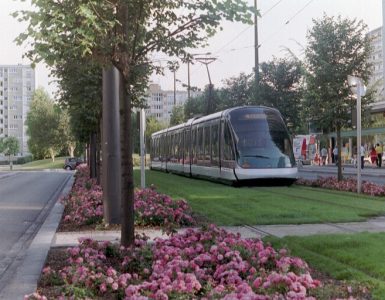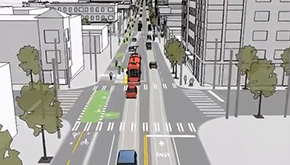 Transportation Nation reports on a plan by the city of Strasbourg in France to reduce that city’s speed limit to 18mph (30km/h) to reduce the incidence of collisions, especially those involving pedestrians and bicycles and to make for a truly shared streets environment. In the report, Mayor Roland Ries is quoted:
Transportation Nation reports on a plan by the city of Strasbourg in France to reduce that city’s speed limit to 18mph (30km/h) to reduce the incidence of collisions, especially those involving pedestrians and bicycles and to make for a truly shared streets environment. In the report, Mayor Roland Ries is quoted:
The public roads no longer belong to automobiles alone. They must be re-imagined to be redistributed in a fairer manner between all forms of transportation. The protection of the most vulnerable is thus reinforced in zones in which all users have access but in which the pedestrian is king.
We like Mayor Reis
Image from Wikipedia






“to be redistributed in a fairer manner between all forms of transportation”
I might take some flack for this but,
This is absolutely slopping thinking about roads. Fairness doesn’t enter into it. The world isn’t “fair” and making arguments about the “fairness” of roads is just childish.
Now what really needs to be done and he probably means this underneath the sloppy thinking, is to efficiently allocate public goods. We all have to use roads and we all ostensibly have an ownership stake in them. Everything is a trade off and you can’t increase the overall “fairness” of a road no matter how much you wish it. You can marginally improve the allocation of resources though.
You can argue that there are many people who want more efficient, safe, pedestrian and bicycle use of the roads. This will come at the expense of car use on the roads. That is not necessarily a bad thing but it shows why thinking about it as “fairness” isn’t going to get you anywhere. The goal is to efficiently balance road use. Making no allocation for bicycle use on the road is stupid. It would be equally stupid to shut down major thoroughfares to car traffic and make them into large tree lined sidewalks.
That being said it is not an argument about the speed limit in Strasbourg. That might be a perfectly wonderful idea and will benefit pedestrians greatly while making only a minor inconvenience for motorists (i.e. it would be a better way to allocate road resources). What the idea is not is a way of making everything more “fair.”
The fairness argument also clouds rational thinking about urban transportation. If the 18mph speed limit turns out to cause disastrous delays without really affecting the incidence of vehicle/pedestrian collisions (once again I am not arguing the merits, this actually seems like it will really reduce collisions without really making a lot of delays, but we cannot know this until it has been implemented) then it must be revised or abandoned. Cloaking it in the imagery of “fairness” makes that much more difficult.
Sorry I just don’t like this kind of sloppy thinking, especially since it is so superficially appealing.
(also please excuse the spelling/grammar errors I just dashed it off)
I would point out, the quote is translated from French, so one cannot be sure if the word “fair” was the exact word choice the Mayor was making.
It’s also worth noting that all of the other infrastructure of Strasbourg is in the enviable position of being set up so that it is actually more of a pain in the ass to have a car there than not, at least in the city center.
I don’t see how a 20 mph speed limit would cause unnecessary delays in a city center. Think about downtown. When can you do more than 20-25 safely? Late night and early morning are really the only times. What should be done is set a citywide speed limit of 20 mph unless otherwise posted (and be sure those other areas are posted). 5 mph less than 25 is not going to cause delays. What causes delays is congestion, accidents, and traffic lights that are not properly synced.
Also, this balance you speak of… I can only think of one word to describe it… fairness. Achieving that balance between automobile, bicycle, and pedestrian makes travel fair for all modes of transportation. Balance and fairness of road use does not mean allowing pedestrians to walk in the street. It does not mean closing down a percentage of streets for pedestrian use. It does not mean turning streets into bike paths. It means making pedestrian or bicycle travel just as safe and efficient as car travel (by efficient, I don’t necessarily mean it takes the same amount of time for a person to walk than it does drive, but that might be the reality depending on how many are using cars). It means cutting roads like Memorial Blvd down in size so we don’t have speedways in the city that are near impossible for a pedestrian to cross. It means making sure all sidewalks and curb cuts (and entrances to crosswalks) are just as cleared of snow as the roads. It means having working crosswalk lights wherever necessary. It means cutting down the speed limit to make travel safer for pedestrians and bicyclists. It means eliminating the right turn on red rule in the city.
It’s all fair. It’s all balance. None of that would seriously impede traffic. And if it does, perhaps all those people driving will re-think it. Perhaps we’ll see more carpools and more bus use. But I will say this as someone who drives most of where I go… I don’t even feel safe in a car on many of these city streets.
Why are pedestrians required to find and press a button on a pole to get a traffic signal to change so they can cross an intersection? Is it because automotive traffic is more important and must always be moving?
Why not ban right turn on red lights in most parts of the city|greater Downtown, Wayland, Olneyville Squares and major commercial strips like Atwells Avenue.
Right turns on reds came from southern California car culture from the 1950s. The regulation was adopted by most of the country following the first oil crisis in the 1970s.
Right-turns-on-red never has been legal, unless a posted for a very few locations, within the 5 boroughs of New York. The reason to allow it would be dangerous for pedestrians.
@Peter: Why are cars required to wait at a red light when no one is coming and it is perfectly safe to enter the intersection?
In our world, both pedestrians and cars need to be accommodated. That’s where there must be a balance. It is unsafe for both motorists and pedestrians if there’s no control. For true balance, there needs to be controls in place because everyone thinks they are the most important. Now, I don’t think that in a city center, like downtown Providence, people should have to press a button (why the walk light won’t change in some parts of downtown unless you press that button is beyond me). It should be automatic with the red light. In fact, that should be the case everywhere in the city.
I like the idea of banning right turns on red everywhere in the city limits, not just in the more dense commercial and residential areas.
In response to Jim’s first paragraph: I am not making a judgment about the practical effects of the law. I don’t think that it will cause much delays either but as I said we won’t know until they put the law in effect and guessing about the possible effects is probably just hand-waving.